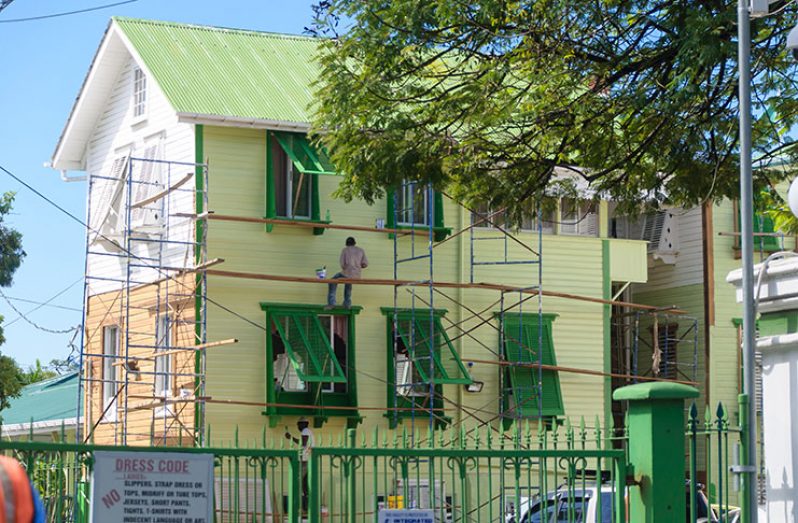DESPITE concerns raised by the National Trust of Guyana last week about the repainting of State House, a heritage building, and the official residence of the President, without consultations, President David Granger on Wednesday said he has broken no law.
“I am not aware that a law has been broken, I am not aware of that … National Trust needs to worry about the President’s decision to ensure that State House is in good repair,” said President Granger.
“It doesn’t leak…we have heritage buildings all around the country. Some of them are collapsing – I weep when I see the condition of City Hall, St George’s Cathedral and I am very concerned about preserving heritage; that’s why I am repairing State House ,” the President told reporters Wednesday.
The head-of-state said he is yet to receive correspondence from the National Trust on the issue. The entity’s Chief Executive Officer (CEO), Nirvana Persaud, told the Guyana Chronicle that it was in the process of communicating with the Ministry of the Presidency on the matter. In fact, Persaud said the repainting of State House is a breach of protocol, in that the procedure for the undertaking of rehabilitation works on national monuments was not adhered to.
Speaking with the Guyana Chronicle briefly last Friday, the CEO explained that there must be consultation with the National Trust and an outline be provided to the entity before any modification is done to national or heritage monuments. “If there are proposed changes, whether it is material, windows or colour, there must be consultation. And that was not done,” she said.
The Guyana Chronicle understands that the National Trust only became aware of this development early last week, although it is situated immediately next to State House. On Friday Persaud said, “The National Trust is dealing with that; we are trying to communicate with the Ministry of the Presidency on the matter.” The white wooden colonial structure which was established in 1854 is now being repainted green and when quizzed about it last week, the President said, “Guyana is going green.”
“I have not seen such a letter…as you know this building was constructed in 1854, there is a lot of rot. Some of the windows are falling off and a decision was taken to repair the rotten portions and to repaint it,” President Granger told reporters while stressing that he has broken no law.
Workmen were indeed repainting the southern section of the property from the original white to shades of green.
Meanwhile, Persaud had explained that the organisation, which was established following the passage of the National Trust Act, No. 7 of 1972, is responsible for the preservation of monuments, sites, places and objects of historic interest or of national importance. And according to the National Trust’s website, its main responsibility is the preservation of all monuments in Guyana.
Under the National Trust Act, the term ‘monuments’ includes any building, structure, object or other work of Man or of nature, whether above or below the surface of the land or the floor of the sea within territorial waters of Guyana and any site, cave or excavation.
“National Monuments are the vested responsibility of the National Trust, and are gazetted as such after approval by Parliament. At present, there are nine gazetted National Monuments,” the website states.
In keeping with its mission to conserve, preserve and promote the nation’s patrimony, so that the present and future generations will access and enjoy the richness of Guyana’s heritage, Persaud said her entity is responsible for the preservation of buildings and or places of national, architectural, historic, artistic or natural interest or importance, and the protection and development of the amenities of such buildings and places and their surroundings.
She said, too, that the preservation of furniture, pictures and chattels of any description having national, historic or artistic interest; the access to and enjoyment of such buildings, places and chattels by the public also fall within the ambit of the entity. President Granger moved into State House shortly after he took office in 2015, and shortly thereafter rehabilitation works began as several sections of the premises were deteriorating.




.png)









